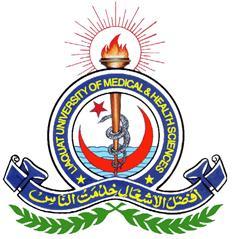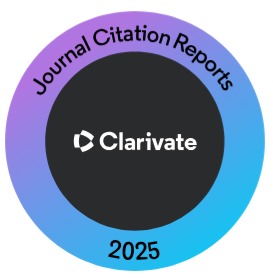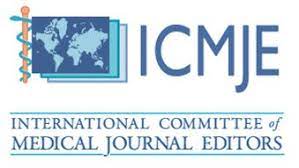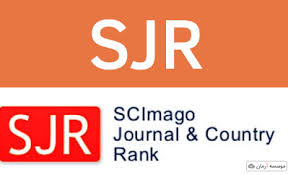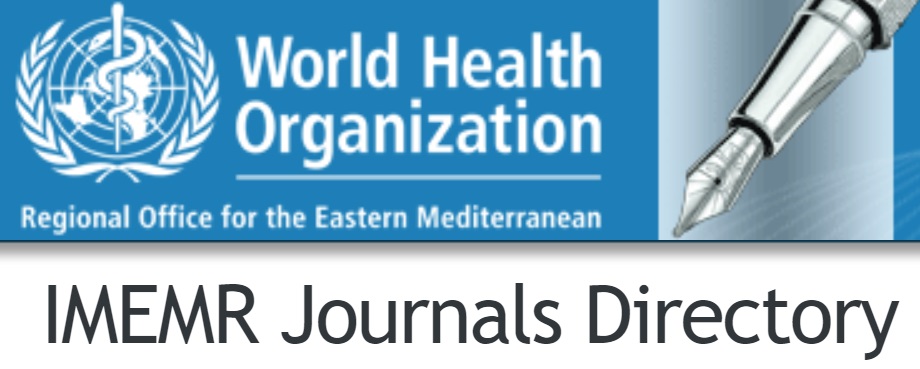A Prospective Cohort Study on Factors of Mortality Due to Acute Organophosphate Poisoning
Keywords:
Poisoning, Organophosphate, Clinical manifestations, Interventions, Outcomes, Prehospital careAbstract
OBJECTIVE: This study assessed the association of demographic characteristics, causes of poisoning, pre-hospital care, clinical manifestations, and treatment with outcomes of organophosphate poisoning.
METHODOLOGY: This prospective cohort study was conducted in the emergency department, medicine wards, and intensive care units of a tertiary care hospital in Sindh, Pakistan, from July 2023 to June 2024. The data were collected using a non-probability purposive sampling technique, as outlined in a questionnaire designed after reviewing the literature. IBM SPSS version 29 was used for analysis using various statistical tools. The categorical variables were presented as frequencies and percentages. A Chi-squared test (Fisher's exact test where required) was used to determine the association between variables.
RESULT: During the study period, 605 patients were enrolled. Organophosphate poisoning (OPP) was prevalent in males (57.2%). Majority of patients were uneducated (70.9%), belonged to rural areas (96.4%), and were aged ?30 years (82%). Poisoning was mainly intentional (92.2%), through oral route (96.9%). Most common clinical manifestation was emesis (55.9%), and circulatory support was provided to 99.3% of patients as a therapeutic intervention. The majority of patients were mildly affected (84.0%) due to OPP, and the death rate was 5.5%. The vital signs, clinical manifestations, interventions, and hospital management had a significant impact on mortality, with p < 0.05.
CONCLUSION: This study's findings emphasize the necessity for healthcare providers to prioritize the rapid assessment and intervention of baseline vitals, typical OPP symptoms, intensive management, duration of hospital stay, and poisoning severity to achieve better outcomes in patients with OPP.
References
Sinha SN, Kumpati RK, Ramavath PN, Sangaraju R, Gouda B, Chougule P. Investigation of acute organophosphate poisoning in humans based on sociodemographic and role of neurotransmitters with survival study in South India. Scientific Reports. 2022; 12(1): 16513.
Orze AK, Flieger W, Szlichta D, Terpiowska B, Terpiowski M, Orze Z et al. Assessment of hospitalizations of patients after intoxication with organophosphates used in agriculture. Ann Agri Environ Med. 2022; 29(1): 143-8.
Reddy BS, Skaria TG, Polepalli S, Vidyasagar S, Rao M, Kunhikatta V et al. Factors associated with outcomes in organophosphate and carbamate poisoning: a retrospective study. Toxicol Res. 2020; 36: 257-66.
Abdel Baseer KA, Gad EF, Abdel Raheem YF. Clinical profile and outcome of acute organophosphate poisoning in children of Upper Egypt: a cross-sectional study. BMC Pediatr. 2021; 21: 1-8.
Shah R, Pokhrel A, Shrestha A, Shrestha S, Sah A, Shah R. Precipitate, preterm labor in acute organophosphate poisoning in pregnancy: a case report. Ann Med Surg. 2024; 86(12).
Balali-Mood M, Saber H. Recent advances in the treatment of organophosphorous poisonings. Iran J Med Sci. 2012; 37(2): 74.
Adeyinka A ME, Regina AC. Organophosphates: StatPearls; 2025. Available from: https://www.ncbi.nlm.nih.gov/books/NBK499860/.
Alva J, Devi ES, Chandrababu R, Abraham J, Balakrishnan JM. Epidemiologic characteristics, the length of hospital stay, and mortality of patients with organophosphate poisoning: A systematic review. Clin Epidemiol Glob Health. 2025; 32: 101932.
Tadesse B, Kibret H, Heluf H, Mesfin S, Alemu Y. Pattern and outcome of acute organophosphate poisoning at health facilities of Harari Region, Eastern Ethiopia. SAGE Open Med. 2023; 11: 20503121231216603.
Naveed S, Tahir SM, Imran N, Rafiq B, Ayub M, Haider II et al. Sociodemographic characteristics and patterns of suicide in Pakistan: an analysis of current trends. Comm Mental Health J. 2023; 59(6): 1064-70.
Statistics PBo. 7th Population and Housing Census-2023: Pakistan Bureau of Statistics; 2024. Available from: https://www.pbs.gov.pk/content/announcement-results-7th-population-and-housing-census-2023-digital-census.
Safdar M, Afzal KI, Smith Z, Ali F, Zarif P, Baig ZF. Suicide by poisoning in Pakistan: review of regional trends, toxicity and management of commonly used agents in the past three decades. BJPsych Open. 2021; 7(4): e114.
Sobeeh FG, Eldayem YBA, Khalifa HK. Validity of different scoring systems in prediction of intensive care unit admission and mortality in acute organophosphate poisoning. Toxicol Res. 2024; 13(4).
Amir A, Raza A, Qureshi T, Mahesar GB, Jafferi S, Haleem F et al. Organophosphate poisoning: demographics, severity scores and outcomes from National Poisoning Control Centre, Karachi. Cureus. 2020; 12(5).
Yousef A, Albuali W, AlOmari M, AlMutairi A, Albuali HW, AlQurashi FO et al. Organophosphate poisoning in a paediatric intensive care unit: a retrospective analysis based on ten years of experience. Int J General Med. 2022; 15: 6269.
Chaokromthong K, Sintao N. Sample size estimation using Yamane and Cochran and Krejcie and Morgan and green formulas and Cohen statistical power analysis by G* Power and comparisons. APHEIT Int J Interdiscipl Soc Sci Technol. 2021; 10(2): 76-86.
Conley K, Rao AL. Risk-Taking Behaviors Among Athletes. Mental Health in the Athlete: Modern Perspectives and Novel Challenges for the Sports Medicine Provider. 2020: 85-93.
Muhammad S, Kumar N, Qureshi Y, Tabassum R, Kumari G, Abbas J et al. Gravity of Poisoning Cases in Shaheed Benazirabad Sindh, Pakistan: A Prospective Study. J Pharmaceut Res Int. 2020; 10.
Govender R, van Niekerk A, Hector TJ, van Tonder W. Self-inflicted ingestion of harmful chemicals in adolescents and adults: risk factors and characteristics. BMC Public Health. 2024; 24(1): 1648.
Yibrie D, Wassie H. Socio-economic problems of Ethiopian young adults as reflected in three selected Ethiopian young adult novels in English. 2020.
Muhammad S, Ahmad R, Rajpoot PL, Tabassum R, Khaskheli MS, Abbas J et al. Threads of Vulnerability: A Cross-sectional Study on Factors Associated with Suicide and Self-harm in Pakistan. Sudan J Med Sci. 2024; 19(2): 173-87.
Alshalati LMJ. Limited knowledge and unsafe practices in usage of pesticides and the associated toxicity symptoms among farmers in Tullo and Finchawa rural kebeles, Hawassa City, Sidama Regional State, Southern Ethiopia. Emerging Contaminants: Intech Open; 2021.
Frazzoli C. Toxicological Risk Analysis in Data-Poor Countries: A Narrative Approach to Feed an "Awareness Raising-Community Empowerment" Vortex. Medicina. 2020; 56(11): 629.
Imran S, Awan EA, Memon MIS, Memon A. Frequency and outcomes of organophosphate poisoning at tertiary care hospital in Nawabshah. Age (years). 2017; 90(134): 23.3.
Al-Mahbashi HM, Howilah AA. A cross-sectional study examining the pattern of acute poisoning among patients admitted to a governmental hospitals in Sana'a City, Yemen. Toxicology Reports. 2024; 13: 101704.
Tefera GM, Teferi LG. Prevalence, predictors and treatment outcome of acute poisoning in Western Ethiopia. Open Access Emergency Med. 2020: 365-75.
Amaro H, Sanchez M, Bautista T, Cox R. Social vulnerabilities for substance use: Stressors, socially toxic environments, and discrimination and racism. Neuropharmacology. 2021; 188: 108518.
Spiller HA, Ackerman JP, Smith GA, Kistamgari S, Funk AR, McDermott MR, et al. Suicide attempts by self-poisoning in the United States among 10–25 year olds from 2000 to 2018: substances used, temporal changes and demographics. Clin Toxicol. 2020; 58(7): 676-87.
Gummin DD, Mowry JB, Beuhler MC, Spyker DA, Brooks DE, Dibert KW et al. 2019 annual report of the American Association of Poison Control Centers' national poison data system (NPDS): 37th annual report. Clin Toxicol. 2020; 58(12): 1360-541.
Nigussie S, Demeke F, Getachew M, Amare F. Treatment outcome and associated factors among patients admitted with acute poisoning in a tertiary hospital in Eastern Ethiopia: a cross-sectional study. SAGE Open Med. 2022; 10: 20503121221078155.
Liu S, Ling L, Ma J, Yuan H, Guo Z, Feng Q et al. Trends and profiles of acute poisoning cases: a retrospective analysis. Front Public Health. 2023; 11: 1235304.
Ng F. Ten-year profile of acute poisoning patients presenting to an Accident and Emergency Department requiring intensive care in a regional hospital of Hong Kong. Hong Kong J Emergency Med. 2019; 26(1): 3-14.
Eizadi-Mood N, Mahvari R, Akafzadeh Savari M, Mohammadbeigi E, Feizi A, Mirmoghtadaei P et al. Acute pesticide poisoning in the central part of Iran: A 4-year cross-sectional study. SAGE Open Med. 2023; 11: 20503121221147352.
Khan NU, Pérez-Núñez R, Shamim N, Khan UR, Naseer N, Feroze A et al. Intentional and unintentional poisoning in Pakistan: a pilot study using the Emergency Departments surveillance project. BMC Emergency Med. 2015; 15: 1-7.
Kumar A, Pappachan JM, Fernandez CJ. Catecholamine-induced cardiomyopathy: an endocrinologist's perspective. Rev Cardiovasc Med. 2021; 22(4): 1215-28.
Espinoza L, da Silva J. 31 Acetylcholine Overload: Organophosphate and Carbamate Exposures. Medical Toxicology. 2024: 352.
Albin CS, Cunha CB, Glaser TP, Schachter M, Snow JW, Oto B, editors. The Approach to Altered Mental Status in the Intensive Care Unit. Seminars in Neurology; 2024: Thieme Medical Publishers, Inc.
de la Torre JC. Hemodynamic instability in heart failure intensifies age-dependent cognitive decline. J Alzheimer's Disease. 2020; 76(1): 63-84.
Yu J-R, Hou Y-C, Fu J-F, Wang I-K, Chan MJ, Chen C-Y et al. Outcomes of elderly patients with organophosphate intoxication. Scientific Reports. 2021; 11(1): 11615.
Krishnasamy N, Narmadhalakshmi R, Prahalad P, Jayalakshmi R, Lokesh R, Ramesh J et al. Determinants of poison-related mortality in tertiary care hospital, South India. Indian Journal of Critical Care Medicine: Peer-reviewed, Indian Soc Crit Care Med. 2024; 28(4): 329.
Thakur DK, Mahaseth R, Jha S. Predictors of Morbidities in Organophosphate Poisoning. IJISRT. 2022; 7(3): 878.
Ramadori GP. Organophosphorus poisoning: Acute respiratory distress syndrome (ARDS) and cardiac failure as cause of death in hospitalized patients. Int J Molecular Sci. 2023; 24(7): 6658.
Ishfaq S, Nazir M, Bukhari S, Ahmed N, Ubaid M, Farooq H. Frequency of organophosphate poisoning and its outcome in SKBZ AK CMH Muzaffarabad. Pak J Med Health Sci. 2023.
El-Gharbawy D, Wahdan A. Predictors of major outcome in acute organophosphorus poisoned cases. Egypt J Forensic Sci Appl Toxicol. 2022; 22(4): 99-114.
Downloads
Published
How to Cite
Issue
Section
License
Copyright (c) 2025 Journal of Liaquat University of Medical & Health Sciences

This work is licensed under a Creative Commons Attribution-NonCommercial-ShareAlike 4.0 International License.
Submission of a manuscript to the journal implies that all authors have read and agreed to the content of the undertaking form or the Terms and Conditions.
When an article is accepted for publication, the author(s) retain the copyright and are required to grant the publisher the right of first publication and other non-exclusive publishing rights to JLUMHS.
Articles published in the Journal of Liaquat University of Medical & health sciences are open access articles under a Creative Commons Attribution-Noncommercial - Share Alike 4.0 License. This license permits use, distribution and reproduction in any medium; provided the original work is properly cited and initial publication in this journal. This is in accordance with the BOAI definition of open access. In addition to that users are allowed to remix, tweak and build upon the work non-commercially as long as appropriate credit is given and the new creations are licensed under the identical terms. Or, in certain cases it can be stated that all articles and content there in are published under creative commons license unless stated otherwise.


